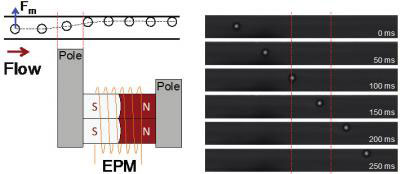| Posted: Jun 20, 2016 |
Electropermanent magnet actuation for droplet ferromicrofluidics
(Nanowerk News) A team of researchers from Stanford University, Stanford, California has demonstrated magnetic actuation of microfluidic water droplets using miniature EPMs and oil-based ferrofluid.
|
|
Water droplets, immersed in a continuous oil ferrofluid phase, experience a repulsive magnetophoretic force in the presence of an inhomogeneous magnetic field. EPMs, capable of generating strong magnetic fields and gradients, are used for the first time in microfluidic applications. Magnetic actuation is an attractive approach to microfluidic manipulation, given that strong magnetic fields can be applied on biological materials or fluids with negligible physiological impact.
|
|
Despite its common use in passive microfluidic systems, there's been limited development of active magnetic actuation methods, mainly due to the limitations of conventional electromagnetic sources. EPMs combine the switching capability of electromagnets with the strength of permanent magnets in a compact package. In this work, Stanford researchers designed, fabricated and integrated EPMs with PDMS microfluidic chips.
|
|
Using fast EPM activation (< 100 µs), forces up to 70 nN and displacement velocities up to 300 µm/s were achieved on 70 µm-diameter water droplets. The report appears in a forthcoming issue of the journal TECHNOLOGY (Technology, "Electropermanent magnet actuation for droplet ferromicrofluidics").
|
 |
| (a) Water droplets are displaced laterally, due to negative magnetophoretic force Fm, generated from a pole of the EPM located 200 µm from the edge of the channel. (b) Water droplet displacement is demonstrated for a 70 µm droplet under continuous flow. Droplet displacement occurs while the droplet traverses the region in close proximity to the long EPM pole (between red dot-ted lines). Channel width is 200 µm. (© World Scientific)
|
|
EPMs are a magnetic assembly consisting of two permanent magnets (one hard -- very difficult to demagnetize, one soft -- easy to demagnetize), two ferromagnetic poles, and a coil. To activate the EPM, a large 50 µs, 7 A current pulse is sent through the coil, inducing a magnetic field strong enough to reverse the magnetization of the soft magnet. By repeating this process with positive and negative current pulses, the soft magnet can be magnetized with equal or opposite magnetization as the hard magnet, thus turning the EPM ON or OFF, respectively. By using thin (350 µm) ferromagnetic poles, localized actuation regions can be achieved within the microfluidic channels. "Given their small, strong and switchable properties, EPMs can be used for active magnetic actuation in microfluidic systems, a method with many potential applications, but currently limited by existing electromagnetic sources," says José I. Padovani, the lead author on this paper.
|
|
"The principal advantage of miniature EPMs over conventional electromagnets is that they require no static power to maintain the ON state, eliminating concerns about Joule heating of the fluid and excessive system power," says Prof. Roger T. Howe, Ph.D., Electrical Engineering Department, Stanford University. "In addition, these hand-assembled miniature EPMs have much higher switching speeds and higher field gradients than are feasible using planar microcoil electromagnets. Also, external electromagnets are capable of generating larger magnetic field strengths than is possible for planar microcoils, but their large size translates into much smaller magnetic field gradients and their larger inductance leads to slower switching times".
|
|
EPM actuation was demonstrated on water droplets ranging from 20 to 85 µm in diameter. The magnetophoretic force for these droplets ranged from 5 to 70 nN, as the force scales with the droplet volume. Displacement speeds up to 300 µm/s were recorded and used to sort droplets in a Y-split sorting junction. These experiments were performed using the maximum EPM activation current. One aspect of the EPM operation that makes them really useful is that using lower activation currents, weaker magnetic fields can be obtained. The magnetic field was measured 600 µm away from the pole with a Gaussmeter at up to 23.4 mT, which translates into a magnetic field of about 300 mT at the edge of the pole.
|
|
The Stanford team is currently developing new applications for EPM actuation in ferro microfluidic systems, as well as optimizing the EPM design. One area of current research is single cell manipulation and analysis using droplet microfluidics. "Magnetic field actuation is an ideal mechanism for live cell manipulation given that magnetic fields have no measurably harmful physiological effects over cells or the media suspension," says Prof. Stefanie S. Jeffrey, M.D., from the Stanford University's School of Medicine and co-author of the paper.
|

